Ready to turn your backyard into a blooming paradise? Start by choosing a sunny spot that bathes your plants in light for 6-8 hours daily! Next, select rot-resistant wood or sleek metal for your beds. A 4×4-foot design gives you just enough room to grow, but don’t shy away from a 4×8-foot option if space allows! Prepare your soil with compost to nourish those roots. Excited to learn how to manage watering and pests for a thriving garden? Keep going!
Choose the Right Location
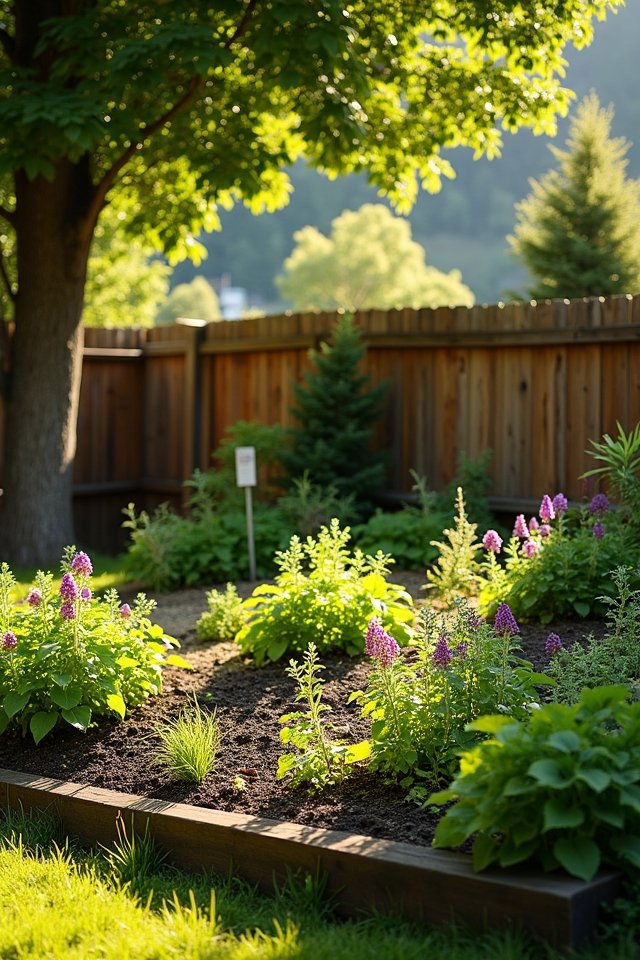
When you’re picking the perfect spot for your raised bed garden, think of it like choosing a great seat at a concert—you want full access to the show! Look for a sunny spot; most veggies thrive with 6-8 hours of sunlight exposure daily. You wouldn’t want to miss an epic guitar solo, right? Avoid shady corners, as they’ll leave your plants longing for that light. Also, consider wind protection; a gusty spot can stress your greens and even topple them! You might plant your bed near a fence or some shrubs for a cozy, sheltered vibe. Picture it: healthy plants swaying gently, not battling the wind! Find that sweet spot, and your garden will thank you with vibrant colors and bountiful harvests!
Select Your Materials
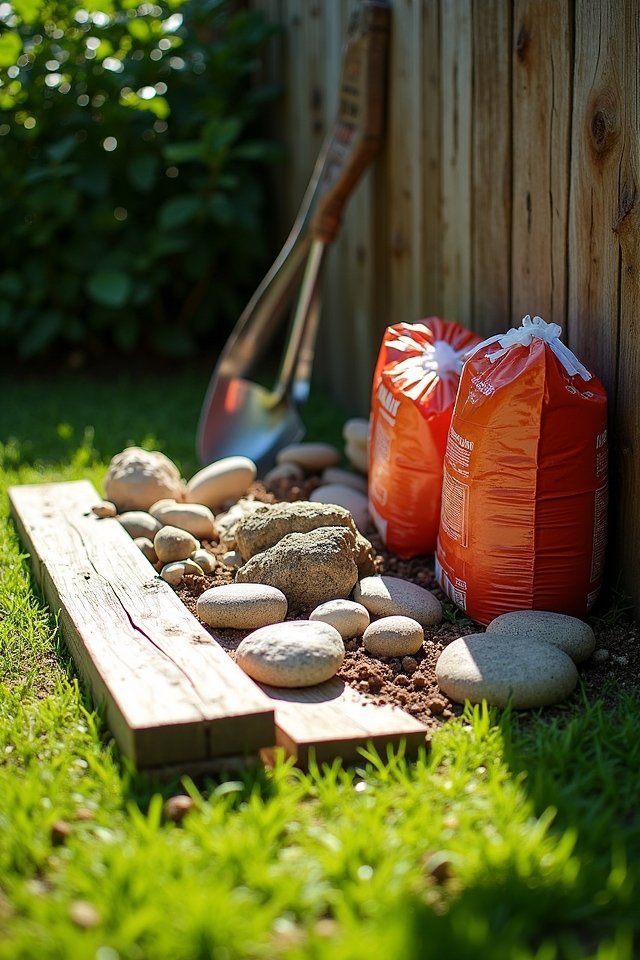
Selecting the right materials for your raised bed garden is like picking the perfect ingredients for a delicious recipe—each choice affects the final dish! When it comes to wood options, consider rot-resistant favorites like cedar or redwood. They can stand up to Mother Nature’s whims and add a warm touch! If you’re feeling edgy, metal choices like galvanized steel or corten can lend a modern flair, while also ensuring durability. Just imagine the striking contrast of bright greens against rusted patina! Your materials set the stage for thriving plants, so don’t skimp! Plus, you can mix and match; who says wood and metal can’t be friends? Immerse yourself, get creative, and let your garden’s unique personality shine!
Determine the Size of Your Beds
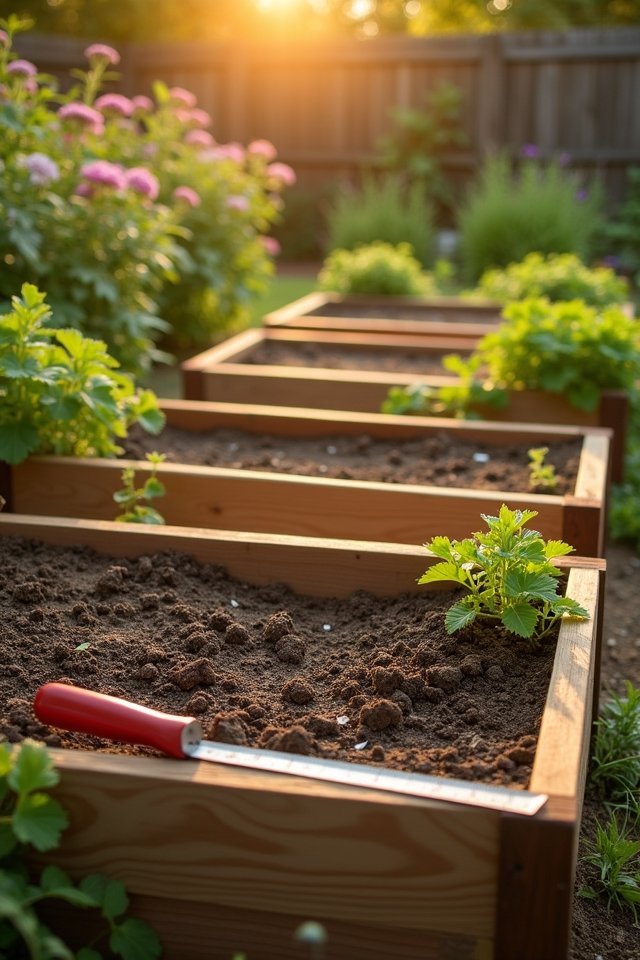
Finding the perfect size for your raised beds can feel like solving a delightful puzzle! When considering bed dimensions, think creatively about your available space and what you want to grow. A 4×4-foot bed is a classic choice, offering plenty of room for a variety of plants while optimizing space efficiency. If you’ve got a bit more room, a 4×8-foot design provides endless possibilities—imagine rows of vibrant carrots, leafy greens, and fragrant herbs! Keep in mind, wider beds might not be easy to reach across. So, strike a balance! Give yourself enough space to access your plants easily. Think about your gardening style; the right dimensions will enhance your garden’s productivity and make your planting experience truly enjoyable!
Prepare the Soil

Preparing the soil is one of the most essential steps in creating your raised bed garden; it’s like setting the stage for an unforgettable show! First, start with soil testing. You wouldn’t want to serve a meal without knowing your ingredients, right? Grab a testing kit from your local garden center and discover your soil’s pH and nutrient levels. Once you’ve got that intel, it’s time to jazz it up with organic amendments like compost, worm castings, or well-rotted manure. These goodies will boost your soil’s fertility and structure, making it a welcoming home for your plants. Think of your soil as a cozy blanket; when it’s fluffy and nutrient-rich, your garden will thrive! Get ready for the bloom of a lifetime!
Plan Your Planting Layout
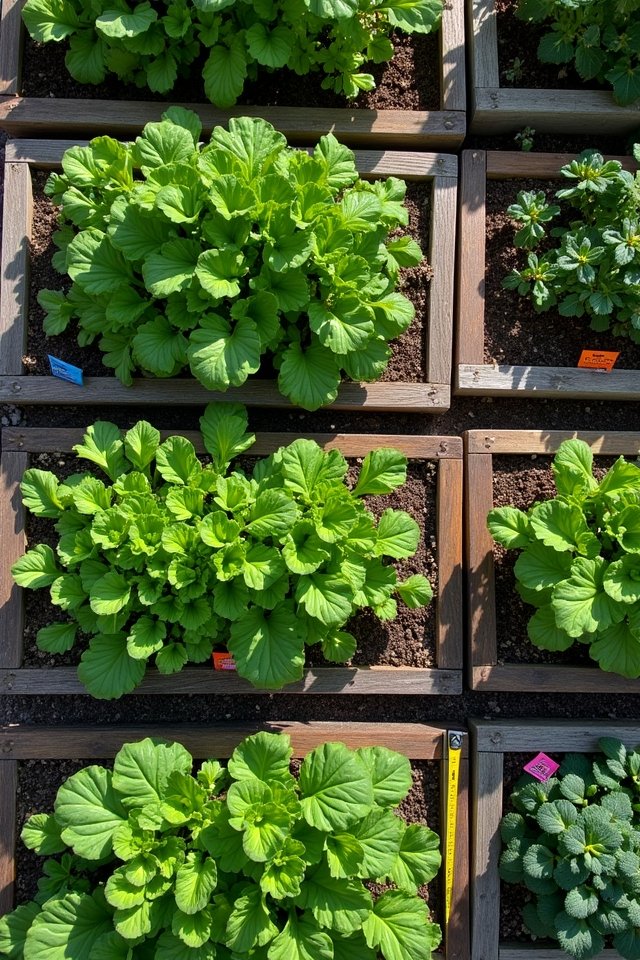
Now that you’ve whipped your soil into shape, it’s time to map out your garden like a treasure hunt for vibrant veggies and beautiful blooms! You’ll want to sketch your planting layout first—think of it as your garden’s secret recipe. Mix and match your plants with eye-catching planting patterns; for example, form rows of colorful stripes or staggering patches like a pixelated quilt!
Don’t forget the magic of crop rotation! This innovative strategy keeps your plants healthy and your soil buzzing with nutrients. Imagine your tomatoes happily swapping spots with peppers next season. Make your garden dynamic and bursting with life by planning a layout that’s not just practical but totally exhilarating! Are you ready to get diggin’?
Consider Companion Planting
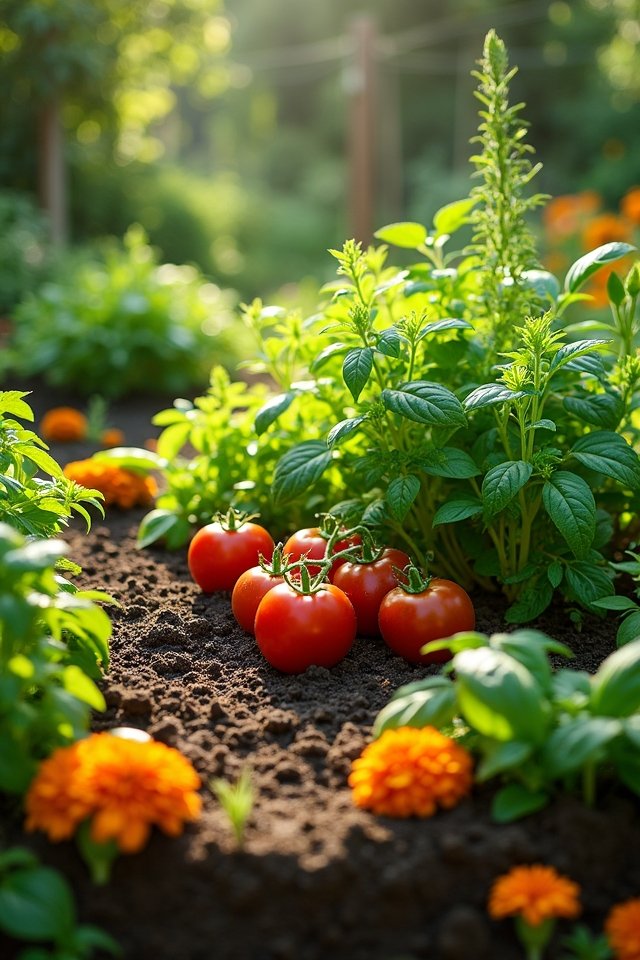
When you immerse yourself in the world of gardening, consider the magic of companion planting—it’s like throwing a party for your plants where everyone gets along! Pairing certain plants can lead to amazing companion plant benefits, like improved growth and pest control. For instance, tomatoes and basil make ideal plant pairs; basil not only enhances the flavor of tomatoes but also helps repel pesky insects! You can create vibrant combinations, too; try planting marigolds with almost anything—they’re nature’s little bodyguards. Remember, happy plants lead to bountiful harvests! So, gather your plant friends wisely and watch your raised bed garden transform into a thriving ecosystem. Who knew growing food could feel like orchestrating a joyful symphony? Let’s get planting!
Watering and Drainage Solutions
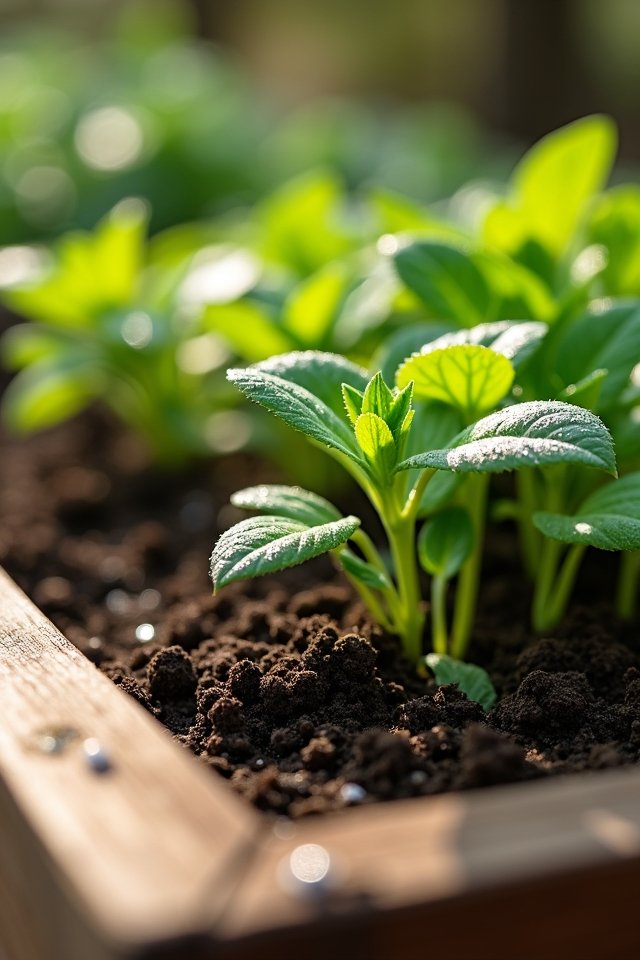
Just like a well-planned party, your raised bed garden needs the right balance of moisture and drainage to keep everything flourishing! Aim for a dance of innovation by integrating drip irrigation as your go-to watering technique; it delivers hydration exactly where needed. You can also consider a soaker hose—perfect for lazy gardeners like you! For drainage options, elevate your bed with slatted bottoms or use gravel to avoid soggy roots. It’s like giving your plants a comfy shoe! Remember, a raised bed demands a watchful eye on soil moisture; test it with your fingers for that perfect touch—just like feeling the beat of your favorite tune! Keep those plants humming, and they’ll reward you with vibrant growth!
Pest and Weed Management
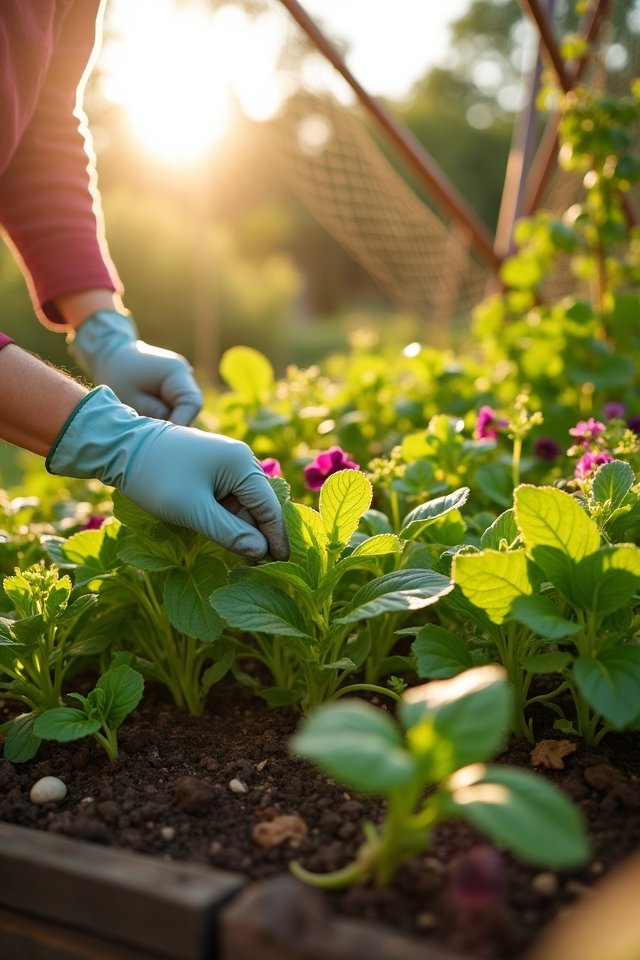
Every gardener knows that pesky pests and weeds can crash the party in your raised bed garden! To keep your plants thriving, welcome natural predators like ladybugs and lacewings. They’re like tiny bodyguards for your veggies, munching on those unwanted intruders. But if the pests still party too hard, don’t worry—organic pesticides can come to your rescue. Think of them as your garden’s secret weapons, gentle yet effective. For weeds, you can use a thick layer of mulch to smother them like a comfy blanket. Regularly pulling them out helps too, just like giving your garden a mini manicure! Remember, keeping your raised bed healthy is all about teamwork—your efforts, and a little help from nature!
Seasonal Care and Maintenance
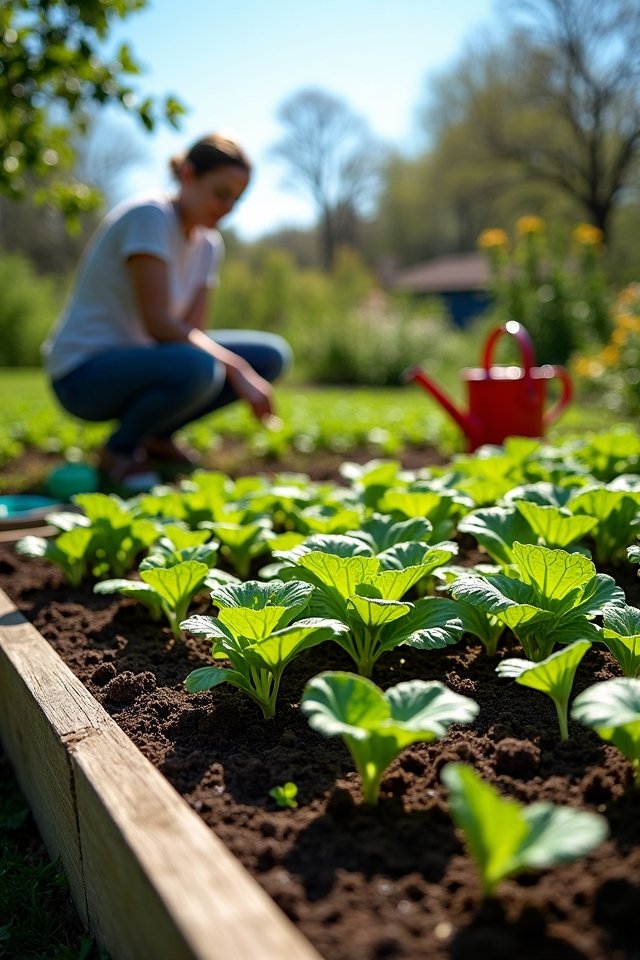
As the seasons change, so does your raised bed garden’s needs! You’ve got to pay attention to seasonal planting and crop rotation to keep things fresh and thriving. Spring’s the time for vibrant greens, while summer loves those juicy tomatoes! Get ready for fall’s root veggies, and don’t forget winter’s cozy cover crops.
Here are some seasonal care tips:
- Mulch to keep soil moisture in check.
- Adjust watering as temperatures fluctuate.
- Plan crop rotation to enhance soil health.
- Prune perennials to encourage new growth.
- Check for pests regularly—don’t let them crash your party!
Harvesting and Enjoying Your Crops
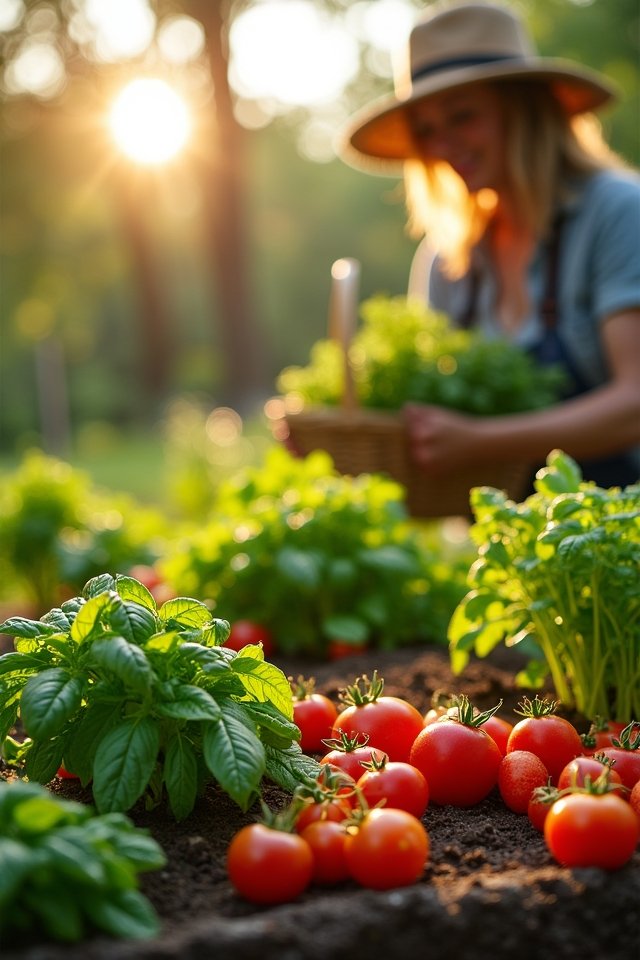
When your crops are ready for harvesting, it feels like unwrapping a present—exciting and full of surprises! Picture that first ripe tomato, glistening in the sun, just waiting to be part of a vibrant salad. Make sure to grab your produce at peak freshness for delightful flavors! After you’ve harvested, think about crop storage to keep everything crisp and tasty. A cool, dry place can work wonders, extending freshness.
And let’s not forget the fun part—recipe ideas! How about sautéing your harvest with garlic for a quick, mouthwatering dish? Or tossing roasted veggies into a creamy pasta? Your raised bed is a treasure trove; explore and enjoy every creative, delicious bite! Happy harvesting!
Frequently Asked Questions
How Much Sunlight Do Raised Beds Need Daily?
Your raised beds crave sunlight! Ideally, they need at least six hours of direct sunlight daily, boosting your plants’ energy like coffee for a sleepy college student. Consider garden orientation; positioning your beds east-to-west maximizes sun exposure. Just like a sun-kissed beach, your plants will thrive! If you’ve got a shadier spot, think about choosing shade-tolerant veggies, but remember, they don’t like to be left out of the sunlight party!
Can I Use Treated Wood for Raised Beds?
Sure, you can use treated wood for your raised beds, but let’s chat about treated wood safety! Chemical treatments can leach into the soil, so it’s often wiser to explore alternative materials. Why not try cedar or redwood? They’re naturally resistant to decay and absolutely gorgeous! Plus, your veggies won’t mind the switch! Stick with non-treated woods to keep your garden safe and vibrant, just like a rainbow after a summer storm!
What Is the Best Time to Start a Raised Bed Garden?
Ah, the irony! You’re enthusiastic to dig into soil, but here you are, waiting! The best time to start your raised bed garden is when the soil warms up, usually around mid-spring. That magic soil temperature is about 60°F. Can you imagine planting seeds and watching new life sprout? The vibrant greens leaping upward will make your heart sing! So, get those gloves on and prepare to welcome the joy of gardening!
How Deep Should My Raised Bed Soil Be?
When it comes to your raised bed, shoot for about 12 to 18 inches of soil depth! This gives your plants room to thrive, just like a cozy bed for sweet dreams. Mix in rich soil composition with organic matter like compost—it’ll boost your garden’s health! Don’t forget about drainage solutions; you don’t want your veggies swimming! So, get ready to dig deep and watch your garden flourish like never before! 🌱
Can I Grow Vegetables in Winter With Raised Beds?
Absolutely, you can grow vegetables in winter with raised beds! It’s like having your own little greenhouse! Think bright green kale, crunchy carrots, and sweet spinach nestled under a blanket of snow. Use row covers to warm the soil and protect your plants from frosty winds. Ever tried growing winter squash? It’s like planting sunshine! With a little creativity, you’ll be harvesting delicious veggies even when the temperatures drop. Isn’t that exciting?


